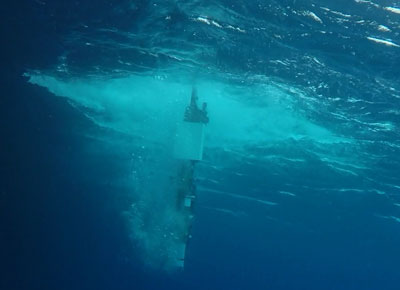Source: Journal of Geophysical Research: Oceans
Earth’s oceans are undeniably blue, but tiny photosynthetic phytoplankton and dissolved organic material absorb and scatter sunlight, creating swaths of lighter blues and greens. Ocean color depends greatly on the growth and health of phytoplankton, so monitoring these hues via satellite can reveal environmental changes and aid the study of climate change.
Scientists studying ocean color rely on data-driven models of the ocean’s optical properties and their relationship with ocean biogeochemistry. New research by Organelli et al. suggests that data from autonomous, oceangoing sensor systems known as Argo floats could help improve these models.
Numbering almost 4000, Argo floats around the world use sensors to take measurements of seawater temperature and salinity, which are relayed to researchers via satellite signals. Argo floats can collect data in harsh ocean conditions that would hamper research ship efforts.
The research team analyzed data from 103 Argo floats equipped with extra “bio-optical” sensors that measure optical and biogeochemical properties of seawater. As it passes through water, sunlight loses its intensity at a rate determined by the biogeochemistry of the water. The team used Argo data to calculate how quickly sunlight loses its intensity at the depth normally “viewed” by satellites that monitor ocean color.

The researchers found that the ocean regions they analyzed could be divided into three different groups, depending on their bio-optical properties. One group consisted solely of the Black Sea, with its particularly high concentration of dissolved organic matter. Another group included the subtropical gyres of the Atlantic and South Pacific oceans. For this group, seawater bio-optical properties were consistent with existing models, although this consistency wasn’t found in the Black Sea. The third group also deviated from existing models; it consisted of high-latitude and temperate seas, including the Norwegian Sea, the North Atlantic and Southern oceans, and the Mediterranean Sea.
Where models showed less accuracy for the first and third groups, the Argo data indicated higher than average levels of colored dissolved organic matter.
Such anomalies could lower the accuracy of optical and biogeochemical measurements made using existing models. Sudden occurrences of these anomalies could signal that an event, such as atmospheric fertilization or submesoscale circulation, is changing the environment. Tracking the distribution of these anomalies over time could also help scientists pinpoint where the marine environment is changing, helping to locate areas most vulnerable to climate change. Thus, further use of Argo floats could allow for improved bio-optical models and better understanding of climate change. (Journal of Geophysical Research: Oceans, https://doi.org/10.1002/2016JC012629, 2017)
—Sarah Stanley, Freelance Writer
Citation:
Stanley, S. (2017), Autonomous floats shed new light on the ocean’s many hues, Eos, 98, https://doi.org/10.1029/2017EO073123. Published on 11 May 2017.
Text © 2017. The authors. CC BY-NC-ND 3.0
Except where otherwise noted, images are subject to copyright. Any reuse without express permission from the copyright owner is prohibited.

